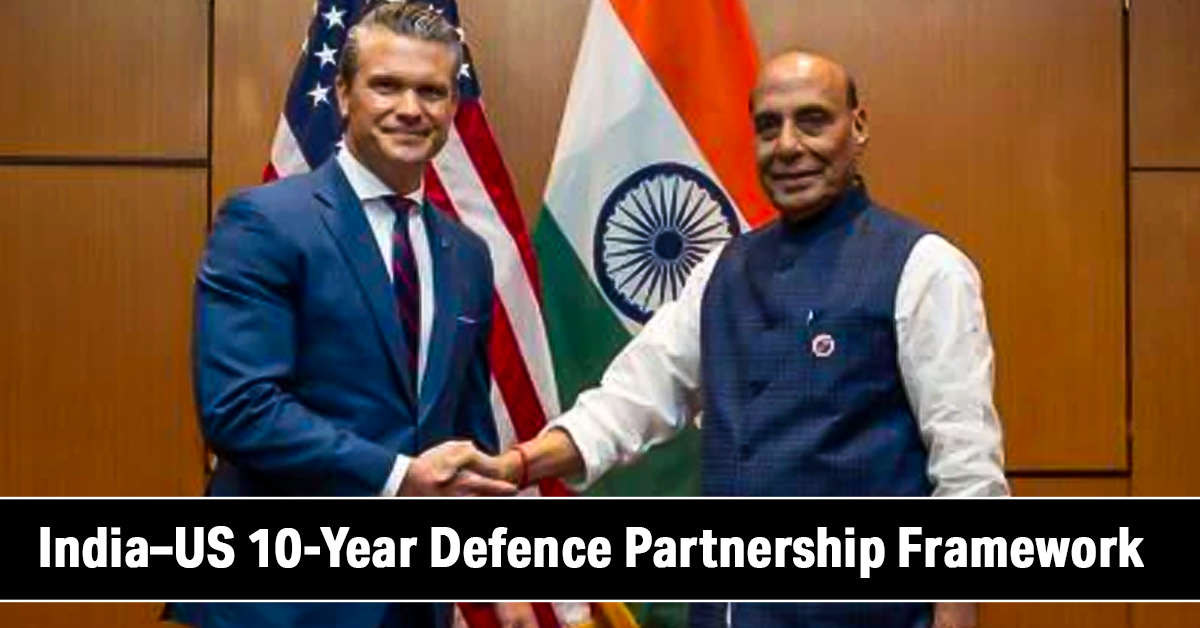Table of Contents
Context
India and the United States signed a landmark 10-year “Framework for the U.S.–India Major Defence Partnership” during the 12th ASEAN Defence Ministers’ Meeting-Plus (ADMM-Plus) in Kuala Lumpur, Malaysia.
Key Highlights of the Framework
- Policy Direction: Establishes an overarching vision for India–U.S. defence engagement through 2035.
- Defence Interoperability: Focus on joint operations, logistics support, and repair/maintenance cooperation.
- Technology Collaboration: Promotes co-development and co-production of advanced military systems, including fighter jet engines and UAVs.
- Information Sharing: Expands intelligence and data-sharing mechanisms for maritime domain awareness and counterterrorism.
- Industrial Partnership: Encourages private sector linkages under Make in India and U.S. Defense Trade and Technology Initiative (DTTI).
- Regional Security: Strengthens coordination within the Quad and partnerships with ASEAN, Japan, and Australia.
- Joint Exercises: Expands joint military drills such as Yudh Abhyas, Vajra Prahar, Malabar, and Cope India.
|
Strategic Significance of the pact |
|
Evolution of India–U.S. Defence Ties
| Phase | Key Agreements / Developments | Significance |
| 2013 | Joint Declaration on Defence Cooperation | Set broad contours for defence partnership. |
| 2015 | Framework for the U.S.–India Defence Relationship | Deepened strategic cooperation and interoperability. |
| 2016–2020 | Signing of foundational agreements – LEMOA (2016), COMCASA (2018), BECA (2020) | Enabled logistics sharing, secure communications, and geospatial cooperation. |
| 2024 | Security of Supply Arrangement (SOSA) and MoA on Liaison Officers | Enhanced defence industrial base collaboration. |
| 2025 | 10-Year Major Defence Partnership Framework | Expands defence cooperation to cover the full spectrum of security and technology. |
Ongoing and Future Defence Cooperation
- Defence Trade and Procurement: India’s inventory includes major U.S.-origin systems:
- C-130J Super Hercules, C-17 Globemaster III, P-8I Poseidon, Apache and Chinook helicopters, M777 Howitzers, and Harpoon missiles.
- Future procurements:
- 31 MQ-9B SeaGuardian/Predator UAVs (HALE drones).
- GE F-414 jet engines for LCA Tejas Mk-2 (to be co-produced in India).
- GE-F404 engines for Tejas Mk-1A deliveries underway.
- Joint Military Engagements: Exercise Yudh Abhyas. 2+2 Dialogue ,Quad Defence Dialogue.
- Industrial and Technological Synergy:
- Collaboration between HAL and GE Aerospace for engine production.
- Expansion of joint research in areas such as AI, cyber, space defence, and semiconductor security.
Challenges and Underlying Frictions
- Trade Disputes: Ongoing tariff imbalances and sanctions risk affecting defence procurement timelines.
- Technology Transfer Hesitations: U.S. export controls and ITAR restrictions slow co-production efforts.
- Geopolitical Balancing: India’s defence ties with Russia and non-alignment posture may create tensions.
- Operational Interoperability: Standardization across communication and logistics systems remains incomplete.
- Political Changes: Future administrations in either country could recalibrate strategic priorities.
Way Forward
- Institutionalize Annual Reviews: Regular high-level dialogue under the new framework for course correction.
- Boost Industrial Collaboration: Implement Indo-U.S. Defence Acceleration Ecosystem (INDUS-X) for startups and MSMEs.
- Expand Tech Partnership: Focus on AI-enabled defence systems, space situational awareness, and cybersecurity cooperation.
- Enhance Interoperability: Broaden joint logistics and maritime domain awareness initiatives.
- Depoliticize Security Cooperation: Keep defence engagement immune from short-term trade or political disagreements.
- Quad Synergy: Use the India–U.S. partnership as the backbone of collective Indo-Pacific security efforts.


 Securities Markets Code Bill 2025: Towar...
Securities Markets Code Bill 2025: Towar...
 Weakly Interacting Massive Particles (WI...
Weakly Interacting Massive Particles (WI...
 India–Oman Trade Deal: CEPA Signed to ...
India–Oman Trade Deal: CEPA Signed to ...

























